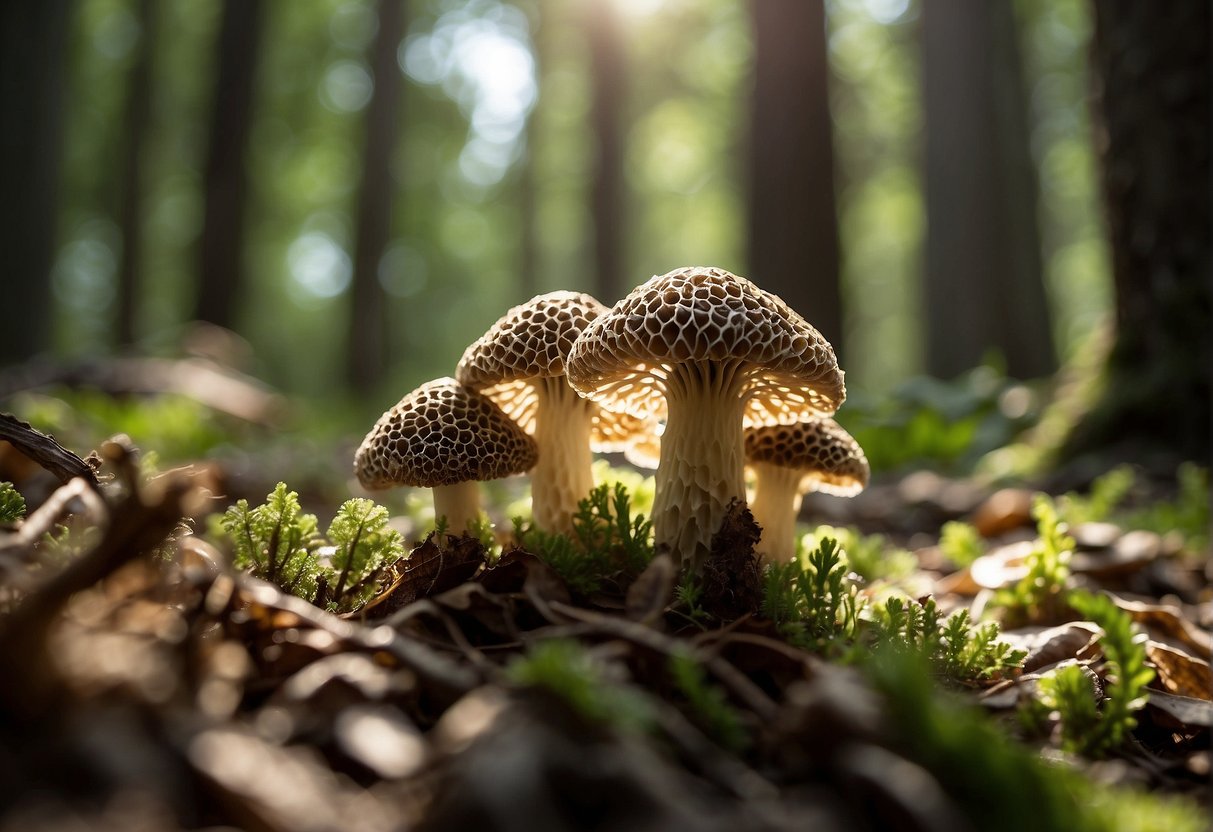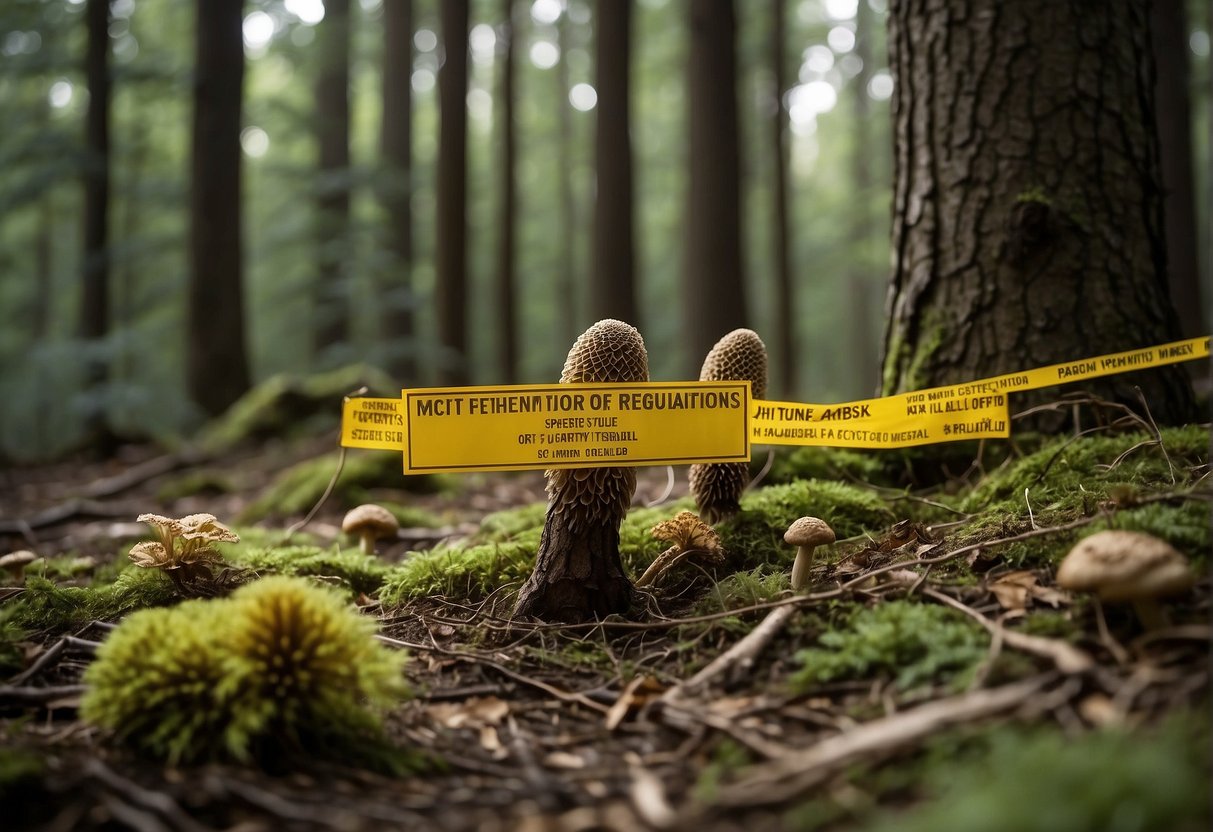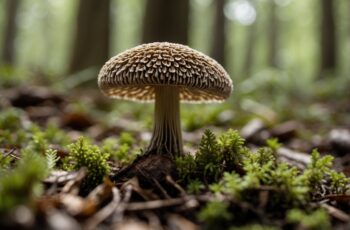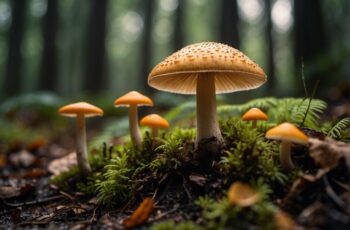Morel mushrooms, a springtime treasure in Michigan, are a source of joy for foragers, culinary enthusiasts, and nature lovers. These distinctive fungi are sought after for their unique flavor and challenging hunt. May is known as morel month in Michigan, but depending on the region and conditions, morel mushrooms can be found from late April until mid-June. With the right knowledge and patience, you can join the many Michiganders who take to the woods each year to search for these elusive mushrooms.

To successfully hunt for morel mushrooms in Michigan, you need to understand their habitat. Morels thrive in moist, wooded areas, particularly in spots where ash, elm, and apple trees are present. Knowing the terrain and climate conditions that favor morel growth is crucial, as is being able to distinguish true morels from their toxic look-alikes. Ensuring you’re foraging responsibly and legally is also part of the adventure, as regulations are in place to protect natural resources and allow for sustainable harvesting.
Key Takeaways
- Morel searching in Michigan provides a fulfilling outdoor activity that blends foraging with natural exploration.
- Knowledge of morel habitats and correct identification techniques is essential for a successful hunt.
- Responsible foraging includes adhering to local laws and sustainable harvesting practices to preserve the ecosystem.
Morel Mushroom Hunting Basics
Venturing into the woods during morel mushroom season is an experience unlike any other. Aspiring and seasoned mushroom hunters alike converge on the forests of Michigan to take part in this rewarding outdoor activity.
Understanding Morel Season in Michigan
Morel mushroom hunting is time-sensitive, as the season spans from late April until mid-June. The peak month to find these elusive fungi is May. Variables such as temperature and rainfall significantly influence the fruiting period. Your prime time for hunting morels might differ depending on whether you’re in southern Michigan or trekking through the Upper Peninsula.
Essential Gear for Mushroom Hunters
To ensure a successful hunt, you’ll need to equip yourself with the appropriate gear. A mesh bag or basket helps to carry and preserve the delicate morels while allowing their spores to disperse, encouraging future growth. Additionally, dressing in layers and wearing sturdy shoes will prepare you for varied terrain and weather changes during your hunt. Always carry a compass or a GPS device; it’s easy to get turned around in the Michigan woods.
Identifying and Foraging Morel Mushrooms
Engaging in the hunt for morel mushrooms in Michigan is as rewarding as it is challenging. Proper identification and knowledge of foraging spots are crucial to ensuring a successful and safe outing.
Where to Find Morels in the Wild
When you’re on the hunt for morels, your best bet is to head into the woods after the ground has thawed and when temperatures are mild. Look for areas with a mix of ash, elm, and aspen trees, as these are often favored by morels. Dead or dying trees, particularly elms, can be particularly fruitful spots. Utilize interactive maps provided by local departments to pinpoint potential hotspots. Remember, respect nature while hiking and foraging; leave no trace, and only take what you’ll use.
Differentiating True Morels from Lookalikes
Identifying a true morel is vital for your safety as false morels are toxic. Here are a few key characteristics to help you distinguish a true morel:
- Cap Shape: True morels have a cap that is pitted and ridged in a honeycomb pattern, as opposed to the wrinkled or lobed appearance of false ones.
- Cap Attachment: On true morels, the bottom of the cap is attached directly to the stem. If there’s a bulge above where the cap attaches to the stem, be wary.
- Stem: True morels have a hollow stem from top to bottom when split open, unlike false morels, which can have cottony or chunky fills.
- Symmetry: True morels are generally symmetrical.
While foraging, always compare your finds to verified images of true morels from reputable identifying guides to confirm that you’ve found an edible mushroom. If you’re ever in doubt, don’t risk it—there will always be another day and another hike to forage. Happy mushroom hunting!
Safety and Regulations

When you’re venturing out into the woods of Michigan to hunt for morel mushrooms, knowing the rules and health precautions is vital to your success and well-being. Let’s take a closer look at what you need to keep in mind regarding public versus private land and the health precautions to take while on the hunt.
Treading on Public vs. Private Land
Know the Boundaries: First and foremost, you must distinguish between public and private lands when hunting morels. The Michigan Department of Natural Resources (DNR) provides an interactive map to guide foragers to areas where morel mushrooms can be found. Rely on this tool and ensure your GPS is on hand to stay within legal foraging grounds. Always respect private property; you’re required to get permission before entering any private lands.
Regulations on Public Land: When you’re on public land, remember the laws are there to protect natural resources. It’s your responsibility to follow the DNR guidelines for foraging. Morels found on public land are for personal use and cannot be sold. Make sure to familiarize yourself with the amount you are allowed to harvest to avoid any legal issues.
Health Precautions while Hunting for Morels
Identifying Morels: Be certain of your identification skills; morels have several look-alikes that can be toxic. Only pick mushrooms that you can positively identify as safe.
Protecting Yourself from Ticks: The same areas that are good for morel hunting are often heavily populated with ticks. Wear long sleeves and pants, use insect repellent, and perform thorough tick checks after your foraging adventure. This will help prevent tick bites, which can lead to serious health problems.
After the Hunt: Cleaning, Cooking, and Preserving
Discovering a trove of morel mushrooms in the wild is your ticket to a delicious feast. Post-hunt, it’s crucial to properly clean and store your morels, as well as explore various cooking methods to bring out their best flavors.
Preparation and Storage Tips
Cleaning: Begin by gently rinsing your morels in cool water to remove any debris. For a more thorough clean, try soaking them in a saltwater solution to dislodge any hidden insects.
- Lay them on a paper towel
- Gently pat them dry
Storing: To preserve the freshness of your morels, drying is a tried and true method. Slice them in half and place them on a dehydrator tray or a wire rack in a low-temperature oven, checking regularly until they’re thoroughly dried.
- If dehydrating isn’t an option, freezing morels is a great alternative. Blanch them first for better results, then freeze in a single layer.
Food Safety Tip: Never store fresh morels in a plastic bag as it can create moisture and lead to spoilage.
Creative Morel Recipes and Cooking Techniques
Cooking: Morels are incredibly versatile when it comes to cooking. They’re excellent sautéed with butter or olive oil, which allows their earthy flavor to shine. Ensure your morels are completely cooked before eating, as consuming them raw can lead to stomach upset.
- For a simple yet delicious approach, sauté chopped morels in butter with garlic, and finish with a sprinkle of fresh herbs.
- Incorporate into risottos or pastas for a rich, gourmet touch.
Recipes: Consider trying something new like morel-stuffed meats or a delectable morel cream sauce for your next steak. Their unique taste complements a wide range of dishes, from the simplest to the most sophisticated.
- Experiment with adding morels to omelets or quiches for a hearty breakfast.
- Create a decadent morel gravy to drape over mashed potatoes or meat roasts.
By ensuring your morels are properly cleaned and stored, as well as experimenting with various recipes and cooking techniques, you can extend the enjoyment of your foraged finds well beyond the mushroom hunting season.


